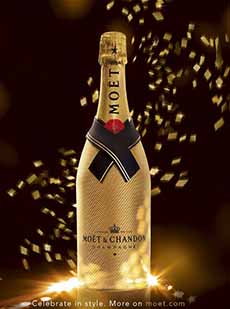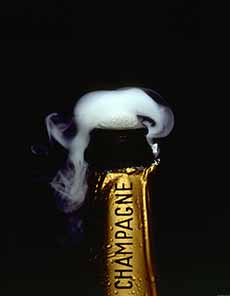|
This year, World Champagne Day will be celebrated on October 23rd. Plan ahead if you’re planning to celebrate!
Although New Year’s Eve is more than two-and-a-half months away, we can’t object to another “official” occasion to drink champagne.
First, an important thing to know: Champagne only refers to the sparkling wines of the Champagne region of France.
Everything else, by law, is called “sparkling wine,” no matter where in the world it is produced.
THE SEVEN LEVELS OF SWEETNESS IN CHAMPAGNE
Champagne is made in seven styles, or levels, of sweetness. The first three, dry wines, are to be paired with savory foods.
The last four are to be paired with sweeter dishes, from lobster thermidor to desserts. Read the footnote* for Extra Dry.
The sweetness comes from a step in the secondary fermentation of Champagne, when the bubbles are created.
The process is called dosage (doe-SAZH): a small amount of sugar is added into the wine bottles before they are corked. The sugar also reduces the tartness/acidity of the wine.
Primary fermentation of Champagne: In the classic méthode champenoise used to make Champagne, Cava and American sparkling wines, the primary, or alcoholic, fermentation of the wine transforms the grape must (the pressed juice of the grapes) into wine. Natural yeast consumes the natural grape sugars, producing alcohol and carbon dioxide.
Secondary fermentation of Champagne: To create a secondary fermentation, the dosage is added to the wine. The the added yeasts eat the added sugar, again creating alcohol and carbon dioxide.
Based on the amount of sugar in the dosage, the seven levels of sweetness based on residual sugar (what’s left after the secondary fermentation) are:
Brut Nature/Brut Zero: 0-3 g/l* residual sugar
Extra Brut: 0-6 g/l residual sugar
Brut: 0-12 g/l residual sugar
Extra Dry†: 12-17 g/l residual sugar
Dry: 17-32 g/l RS residual sugar
Demi-Sec: 32-50 g/l residual sugar
Doux: 50+ g/l residual sugar
MORE ABOUT CHAMPAGNE
How Champagne Is Made
How To Buy Champagne
Low Cost Champagne & Other Sparkling Wines
Holiday Champagne Alternatives
Cava, Spanish Sparkling Wine
More Champagne Alternatives
Rosé Champagne Alternatives
CHAMPAGNE TOOLS
How To Pour Champagne
Why You Need A Champagne Recorker
…Or A Champagne Cap
How To Chill Champagne Quickly
RECIPES: CHAMPAGNE COCKTAILS
Bellini
Kir Royale
Make Your Own Cold Duck“>Make Your Own Cold Duck
Red & Green Champagne Cocktails
Rosé Champagne & Grapefruit Mimosa Cocktail
FOOD WITH CHAMPAGNE
Appetizers With Champagne
Berries In Champagne
Champagne Jell-O Shots
Champagne & Oysters
Champagne & Turkey
Champagne & Sorbet
Champagne Vinaigrette
Champagne With Chocolate
Drunken Fruit
Rosé Champagne With Turkey
Sorbet Champagne Desserts
> THE HISTORY OF CHAMPAGNE
|
|

[1] During the holiday season, you can find bottles with special packaging. Stock up for gifting occasions throughout the year (photo © Moet et Chandon).

[2] Only wines grown and made in the Champagne region of France can be legally called Champagne. Everything else is “sparkling wine” (photo © Champagne Bureau).

[3] The ideal glass to showcase champagne is the flute (photo © American Club Resort).

[4] Rose champagne gets its color from allowing the just-pressed use “skin contact” with the red grape skins from which it is pressed. “Pink champagne” is an inexpensive product with color added (photo © Rocky Slims | NYC [permanently closed]).
|
|
________________________________________
*It’s a paradox in the Champagne industry that “dry” indicates a sweeter wine; as do sec (which means dry in French) and demi-sec. Doux, the sweetest style of Champagne, does mean sweet.
†Grams per liter.
|






